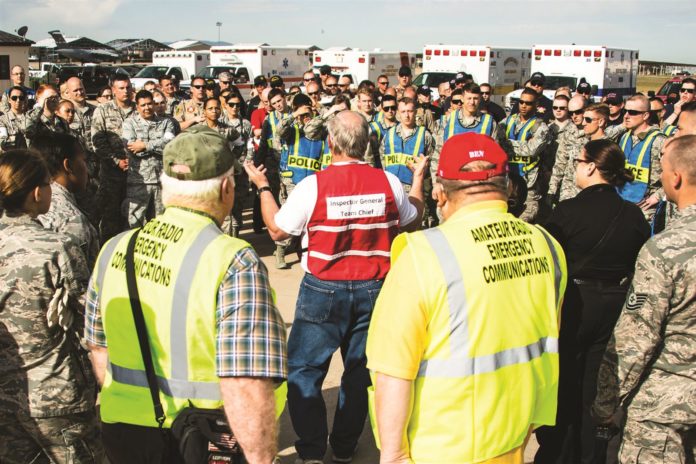From the safety crow’s nest, 2011 has been a very revealing year. In North America, the 2009 and 2010 air show seasons were comparatively uneventful, but this year has been substantially more tumultuous. From a world-wide perspective, one can see the beginnings of a pattern of deficiency at air shows in North America and around the world. While a simple deficiency is easily correctible, it has the potential to become more serious and of much greater concern if it lingers unrecognized and unaddressed.
Our analysis indicates that one such potentially undetected problem for many air show event organizers is their emergency response plan. We have used the ICAS Operations Bulletin (Ops Bull) to discuss this topic before, but, as a proactive measure, we want to discuss it again here and in greater detail. From my perspective, there have been several recent accidents and incidents in which emergency response issues played – or could have played – some role. In a few cases, the response was excellent: fast, professional, successful and well-executed. But, as often is the case, we can actually learn more from those responses that were deficient in some way.
What constitutes a good emergency response plan? While space in this publication prohibits me from fully answering that question, one sentence should suffice for our purposes here. A good plan is a one that, in the event of an accident, either in front of or behind the crowd line, provides the greatest mitigation of all risks and provides the greatest possible protection of any affected parties. Put more simply, the best emergency response plan prevents the most injuries and saves the most lives.
There are many considerations, of course, for the development and perfection of a well-designed and easily executable response plan. While the general goal of all plans is similar, the practical application and use of those plans will vary from show site to show site. An over-water show’s response plan will share some of the same aspects as those of a show on an Air Force base in the middle of a desert; however, there will be several pronounced differences. A show over water will need to have trained life-guards, emergency underwater extraction experts, oxygen bottles, jet skis and small rafts with oversized motors to quickly reach and safely extract a pilot whose aircraft impacts the water. By comparison, a show at an Air Force base in the desert will obviously need none of those things; but that desert-based show will still need things that an over-water show will not: fire trucks and emergency medical technicians with unimpeded access to the aerobatic box, firefighting equipment, strategies for navigating the taxiways, and equipment to lift and/or rotate the aircraft.
Another sign of a strong response plan is that it is familiar to people other than first responders. Any person involved with the air show should know what their responsibility is in the event of an emergency. Obviously, preparing for every possible permutation of a problem is impossible; however, being prepared for several options will give your team a higher chance of success at overcoming unforeseen problems. As any performer, event organizer or air show spectator who has ever been present at an emergency will tell you, there is no such thing as planning and discussing too much. A preparatory brief with all volunteers should be scheduled about a week before the start of the air show and should be led by those who developed the air show’s response plan.
As a member of ICAS, you have access not only to the knowledge of the ICAS staff, but — more importantly — to the knowledge of hundreds of ICAS members with astoundingly deep experience in both the planning and execution of emergency response plans. Several air shows have shared the details of their plans on the ICAS website. (You will find details on how to access that information at the end of this article.)
No one looks forward to executing their emergency plan. But, if your hope that it will not be necessary prompts you prepare – or not prepare – as though you WILL NOT need to execute that plan, then you have done a disservice to yourself and to the individuals who may find themselves in the position of needing you to execute it as though you had practiced it every day. There is no shortage of written direction on how to develop, practice and execute an air show’s emergency plan. The problem has always been an air show’s commitment to integrating emergency response planning into their air show preparations each year with the sense of immediacy and seriousness that it requires.
While the pattern of inadequately prepared response plans has not yet developed into a full epidemic, the pressure is increasing on true air show professionals to proactively engage on this issue and develop a customized, organic plan that they can execute confidently, reliably and professionally should the need arise. There are many aspects of air show management that are well-suited to the trial-and-error style of learning; air show emergency response is not one of them.
ADDITIONAL RESOURCES
The “Event Organizer Resources” area of the ICAS website includes more than 20 different documents relating to emergency response. They include sample emergency response plans from other air shows and a security and emergency response planning power point presentated at a past ICAS Convention. To see a list (which includes a short description of each item), visit this page (https://www.airshows.aero/Docs/75) on the ICAS website.
For a five-page article on the critical components of a comprehensive emergency response plan first published in the Fourth Quarter, 2005 issue of Air Shows Magazine, visit:https://www.airshows.aero/docs/2005%204Q%20The%20Comprehensive%20Air%20Show%20Emergency%20Response%20Plan.pdf
For an article on why air shows need a crisis management media plan first published in the Fourth Quarter, 2005, visit: https://www.airshows.aero/docs/2005%204Q%20Why%20Air%20Shows%20Need%20a%20Crisis%20Media%20Strategy.pdf








